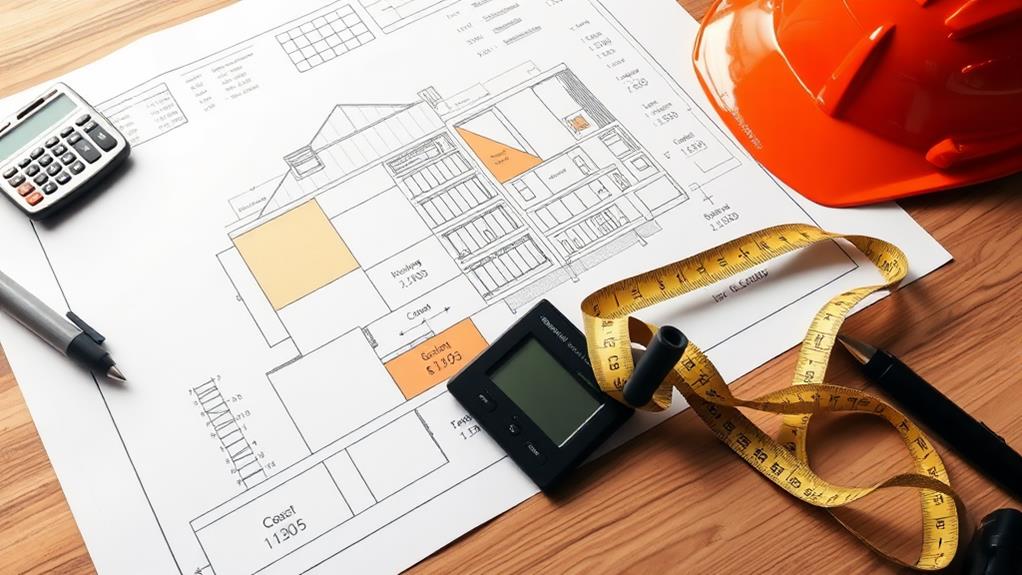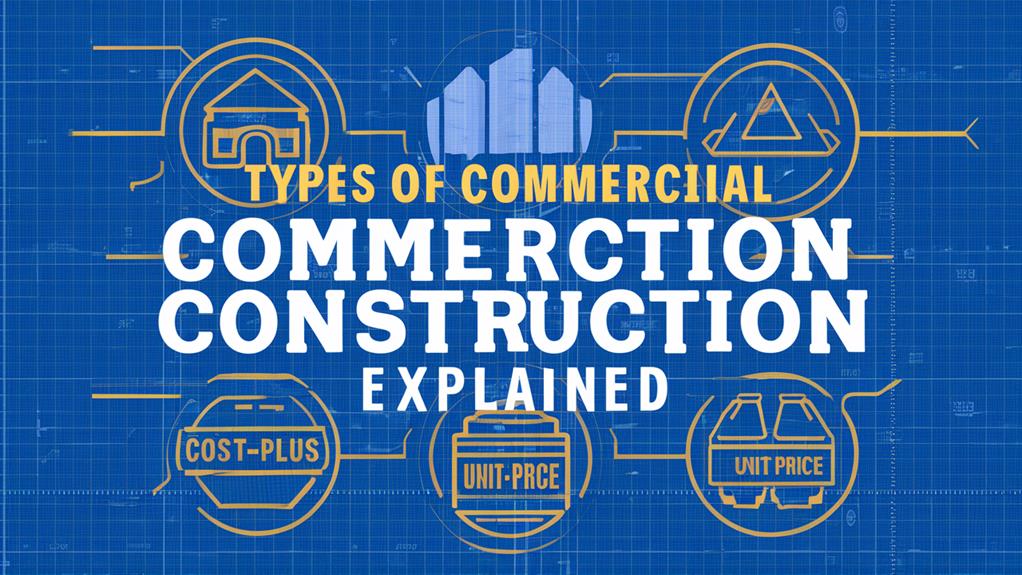There are seven main types of commercial construction contracts that you should know. Lump sum contracts set a fixed price for all the work, while cost plus contracts cover expenses plus a profit margin. Time and materials contracts let you pay for actual labor and materials used, and unit price contracts charge based on measurable work units. Guaranteed maximum price contracts cap costs for security, and design-build contracts merge design and construction to streamline the process. Lastly, integrated project delivery contracts enhance collaboration among all participants. Learning about these types can help you make informed decisions for your construction projects.
Lump Sum Contracts

In a lump sum contract, you're agreeing to a fixed total price for all construction work, making it a straightforward option for projects with a clear scope and little expected change.
These fixed price contracts benefit both owners and contractors by simplifying the bidding process. You can easily compare contractor proposals based on a single price, promoting competitive pricing and potentially lowering costs. This type of contract is particularly advantageous in commercial construction projects where the scope is well-defined, such as office buildings designed for functionality.
However, lump sum contracts transfer the risk of cost overruns to the contractor. If unforeseen site conditions arise or the design changes, the contractor must absorb those extra costs.
This emphasizes the importance of accurate project estimation and diligent project management. While you won't need to supervise every detail during construction, it's crucial to track any changes carefully to avoid disputes over scope alterations.
Time and Materials Contracts
Time and Materials (T&M) contracts offer a flexible approach to managing construction projects, especially when the scope is uncertain or likely to evolve. These contracts reimburse contractors based on the actual costs of labor and materials used, ensuring that project expenditures align with real-time needs.
You'll find that T&M contracts typically include an agreed-upon hourly rate for labor and a set price for materials, which helps provide transparency in costs. However, this flexibility requires close monitoring to prevent budget overruns, making effective project management crucial for success in these scenarios comprehensive planning tailored.
T&M contracts are particularly beneficial for long-term projects or those with unpredictable conditions, allowing adjustments in labor and material usage without extensive renegotiation. Yet, without a not-to-exceed clause, there's a risk for owners due to potential cost escalations. That's why clear communication between the contractor and owner is essential.
Effective management of T&M contracts involves diligent tracking of hours worked and materials used. This ensures accurate billing and minimizes disputes over final costs.
Unit Price Contracts

Unit price contracts are a popular choice for construction projects where tasks are repetitive or quantifiable. These contracts involve payment based on predetermined rates for each measurable unit of work completed. This structure offers flexibility, allowing costs to adjust based on actual quantities used, which can help you with budgeting and forecasting.
With the increasing focus on energy efficiency and green certifications, unit price contracts can also facilitate the incorporation of sustainable practices in project execution.
One of the key advantages of unit price contracts is their ability to simplify the tracking and billing processes. Payments are made according to the actual units of work performed rather than a fixed total price, providing transparency in costs.
However, it's important to note that contractors face risks, particularly the challenge of underestimating quantities. If the actual work exceeds estimates, it can impact profit margins.
Unit price contracts are commonly used in public works and infrastructure projects because they adapt well to varying project scopes and quantities. This adaptability can make managing large-scale projects more efficient.
Cost Plus Contracts
Navigating the complexities of construction projects can be challenging, especially when scopes aren't clearly defined. Cost plus contracts can be the perfect solution in such situations. These contracts reimburse contractors for all incurred expenses plus an agreed-upon profit margin, which makes them ideal for unpredictable projects.
However, they require careful monitoring to ensure transparency and accountability in financial management.
Here are some key points to consider with cost plus contracts:
- Expenses: All costs incurred by the contractor are covered.
- Profit Margin: An agreed-upon percentage is added to those expenses for the contractor's profit.
- Not to Exceed Clauses: These clauses help limit overall expenses, providing some financial protection for you as the owner.
- Flexibility: This contract type allows for adjustments when unexpected costs arise without extensive renegotiation.
While cost plus contracts reduce financial risk for contractors, they may lead to higher overall expenses for owners if not closely monitored.
To make the most of these contracts, focus on tracking expenses diligently and maintaining open communication with your contractor to ensure a successful project outcome.
Design Build Contracts

Design-build contracts revolutionize the construction process by merging design and construction phases into one streamlined agreement. This approach speeds up project delivery by allowing work to begin before the design is fully finalized.
You'll notice a significant improvement in collaboration and communication between designers and contractors, reducing conflicts that often arise in traditional contracts.
One of the key benefits of a design-build contract is its flexibility. It allows for design changes throughout the construction process, promoting innovation and efficiency. Although you might encounter higher initial costs due to reduced competitive bidding, these contracts can lead to cost savings. This happens by eliminating delays linked to miscommunication and unexpected design changes.
Moreover, the integrated nature of design-build contracts aligns everyone's interests, enhancing overall project outcomes. Everyone involved, from the architects to the builders, works together towards a common goal, ensuring the project runs smoothly.
This teamwork fosters a positive working environment, which is crucial for a successful construction project. So, if you're looking for a more efficient way to manage your construction needs, consider the advantages that a design-build contract can offer.
Guaranteed Maximum Price Contracts
Guaranteed Maximum Price (GMP) contracts often provide a sense of financial security for project owners by capping the total cost of construction. This arrangement not only protects your budget but also shifts the risk of cost overruns to the contractor.
By using GMP contracts, you can expect several benefits:
- Financial Certainty: You know the maximum amount you'll need to pay, which helps with budgeting.
- Detailed Pre-Construction Estimates: These contracts require thorough planning and estimates, ensuring every aspect is accounted for.
- Cost-Effective Practices: Contractors are motivated to manage costs well, as any excess falls on them. This promotes efficient use of resources.
- Savings Sharing: If the project comes in under budget, you and the contractor can share the savings, providing further incentives to keep costs down.
Additionally, GMP contracts minimize change orders due to their comprehensive planning phase. This helps maintain project timelines and reduces disputes, leading to a smoother construction process.
Integrated Project Delivery Contracts
In recent years, Integrated Project Delivery (IPD) contracts have gained popularity for their ability to foster collaboration among all stakeholders involved in a construction project. These contracts create a multi-party agreement that aligns the interests of owners, contractors, and designers, promoting shared risk throughout the project lifecycle.
One of the key benefits of IPD is the early involvement of all stakeholders, which leads to innovative problem-solving and streamlined decision-making. This collaboration can significantly reduce project timelines and costs.
Additionally, IPD emphasizes transparency in project costs and performance, which enhances trust among the parties involved.
Financial incentives, such as profit-sharing arrangements, are often included in IPD contracts. These incentives encourage everyone to focus on delivering the project within budget and on schedule.
The collaborative nature of IPD contracts can lead to improved project outcomes, as studies show that projects using this delivery method often achieve higher quality results at lower overall costs compared to traditional contract types.
Conclusion
In conclusion, understanding the different types of commercial construction contracts can help you make informed decisions for your projects. Each contract type has its own strengths and weaknesses, much like choosing the right tool for a job. By knowing which contract suits your needs best, you can navigate the construction process more smoothly and avoid potential pitfalls. So, arm yourself with this knowledge, and you'll be well-prepared to build your dreams into reality!


Leave a Reply